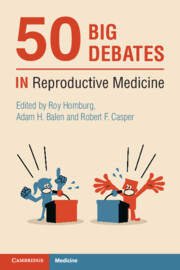Book contents
- 50 Big Debates in Reproductive Medicine
- Series page
- 50 Big Debates in Reproductive Medicine
- Copyright page
- Contents
- Contributors
- Foreword
- Introduction
- Section I Limits for IVF
- Section II IVF Add-ons
- Section III The Best Policy
- 14A IVF Should Be First-Line Treatment for Unexplained Infertility of Two Years Duration
- 14B IVF Should Be First-Line Treatment for Unexplained Infertility of Two Years Duration
- 15A Single Embryo Transfer Should Be Performed in All IVF Cycles
- 15B Single-Embryo Transfer Should Be Performed in All IVF Cycles
- 16A The Freezing of All Embryos Should Be Used for All IVF Cycles
- 16B The Freezing of All Embryos Should Be Used for All IVF Cycles
- 17A Luteal-Phase Support Should Be Stopped at the Time of a Positive Pregnancy Test
- 17B Luteal Phase Support Should Be Stopped at the Time of a Positive Pregnancy Test
- 18A A Natural Cycle Is the Best Protocol for Frozen Embryo Replacement
- 18B A Natural Cycle Is the Best Protocol for Frozen Embryo Replacement
- 19A All Pregnancies Conceived by IVF Should Be Delivered by Caesarean Section
- 19B All Pregnancies Conceived by IVF Should Be Delivered by Caesarean Section
- 20A Endometriosis Should Be Suppressed for 6–12 Weeks before Frozen Embryo Transfer
- 20B Endometriosis Should Be Suppressed for 6–12 Weeks before Frozen Embryo Transfer
- 21A Infertile Patients with Endometriosis Benefit from Surgery
- 21B Infertile Patients with Endometriosis Benefit from Surgery
- 22A Intramural Fibroids Greater than 4 cm in Diameter Should Be Removed to Aid Fertility
- 22B Intramural Fibroids Greater than 4 cm in Diameter Should Be Removed to Aid Fertility
- 23A All Infertile Women with a Uterine Septum Should Have a Surgical Removal
- 23B All Infertile Women with a Uterine Septum Should Have a Surgical Removal
- Section IV Embryology
- Section V Ethics and Statistics
- Section VI Male-factor Infertility
- Section VII Genetics
- Section VIII Ovarian Stimulation
- Section IX Hormones and the Environment
- Index
- References
22A - Intramural Fibroids Greater than 4 cm in Diameter Should Be Removed to Aid Fertility
For
from Section III - The Best Policy
Published online by Cambridge University Press: 25 November 2021
- 50 Big Debates in Reproductive Medicine
- Series page
- 50 Big Debates in Reproductive Medicine
- Copyright page
- Contents
- Contributors
- Foreword
- Introduction
- Section I Limits for IVF
- Section II IVF Add-ons
- Section III The Best Policy
- 14A IVF Should Be First-Line Treatment for Unexplained Infertility of Two Years Duration
- 14B IVF Should Be First-Line Treatment for Unexplained Infertility of Two Years Duration
- 15A Single Embryo Transfer Should Be Performed in All IVF Cycles
- 15B Single-Embryo Transfer Should Be Performed in All IVF Cycles
- 16A The Freezing of All Embryos Should Be Used for All IVF Cycles
- 16B The Freezing of All Embryos Should Be Used for All IVF Cycles
- 17A Luteal-Phase Support Should Be Stopped at the Time of a Positive Pregnancy Test
- 17B Luteal Phase Support Should Be Stopped at the Time of a Positive Pregnancy Test
- 18A A Natural Cycle Is the Best Protocol for Frozen Embryo Replacement
- 18B A Natural Cycle Is the Best Protocol for Frozen Embryo Replacement
- 19A All Pregnancies Conceived by IVF Should Be Delivered by Caesarean Section
- 19B All Pregnancies Conceived by IVF Should Be Delivered by Caesarean Section
- 20A Endometriosis Should Be Suppressed for 6–12 Weeks before Frozen Embryo Transfer
- 20B Endometriosis Should Be Suppressed for 6–12 Weeks before Frozen Embryo Transfer
- 21A Infertile Patients with Endometriosis Benefit from Surgery
- 21B Infertile Patients with Endometriosis Benefit from Surgery
- 22A Intramural Fibroids Greater than 4 cm in Diameter Should Be Removed to Aid Fertility
- 22B Intramural Fibroids Greater than 4 cm in Diameter Should Be Removed to Aid Fertility
- 23A All Infertile Women with a Uterine Septum Should Have a Surgical Removal
- 23B All Infertile Women with a Uterine Septum Should Have a Surgical Removal
- Section IV Embryology
- Section V Ethics and Statistics
- Section VI Male-factor Infertility
- Section VII Genetics
- Section VIII Ovarian Stimulation
- Section IX Hormones and the Environment
- Index
- References
Summary
Uterine fibroids may cause infertility, depending on their size and their location [1]. The mechanisms linking uterine fibroids and infertility are numerous: uterine cavity distortion according to the FIGO classification; impaired endometrial and myometrial blood supply; increased uterine contractility; hormonal, paracrine and molecular changes; impaired endometrial receptivity and gene expression (decrease in homeobox 10 [HOXA-10] expression); and thicker capsule. The effect on infertility of fibroids distorting the cavity is easy to understand. We will also review the influence of non-cavity-distorting intramural fibroids.
- Type
- Chapter
- Information
- 50 Big Debates in Reproductive Medicine , pp. 117 - 119Publisher: Cambridge University PressPrint publication year: 2021

